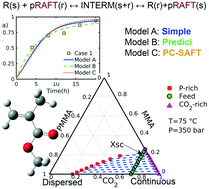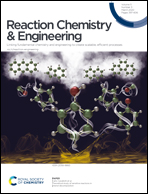Modeling of RAFT polymerization of MMA in supercritical carbon dioxide using the PC-SAFT equation of state
Abstract
The kinetics and evolution of molar mass averages for reversible addition–fragmentation chain transfer (RAFT) dispersion polymerization of vinyl monomers in supercritical carbon dioxide (scCO2) is addressed using three mathematical models (models A, B and C). Models A and C are based on the method of moments. The partition of components is calculated using simple partition equations in model A, whereas the perturbed-chain statistical associating fluid theory (PC-SAFT) equation of state is employed in model C. On the other hand, in model B, the polymerization scheme and mass transport of the species among the present phases are calculated by using the Predici® commercial software. The PC-SAFT equation of state is also used to calculate the solubility of oligomers in the reaction mixture. The calculated profiles of monomer conversion versus time and molar mass averages versus conversion are compared with available experimental data for dispersion polymerization of methyl methacrylate (MMA) in scCO2, using 2,2′-azobis(2-methylpropionitrile) (AIBN) and S-thiobenzoyl thioglycolic acid (TBTGA) as initiator and controller, respectively. The effects of temperature and pressure are also analyzed.



 Please wait while we load your content...
Please wait while we load your content...